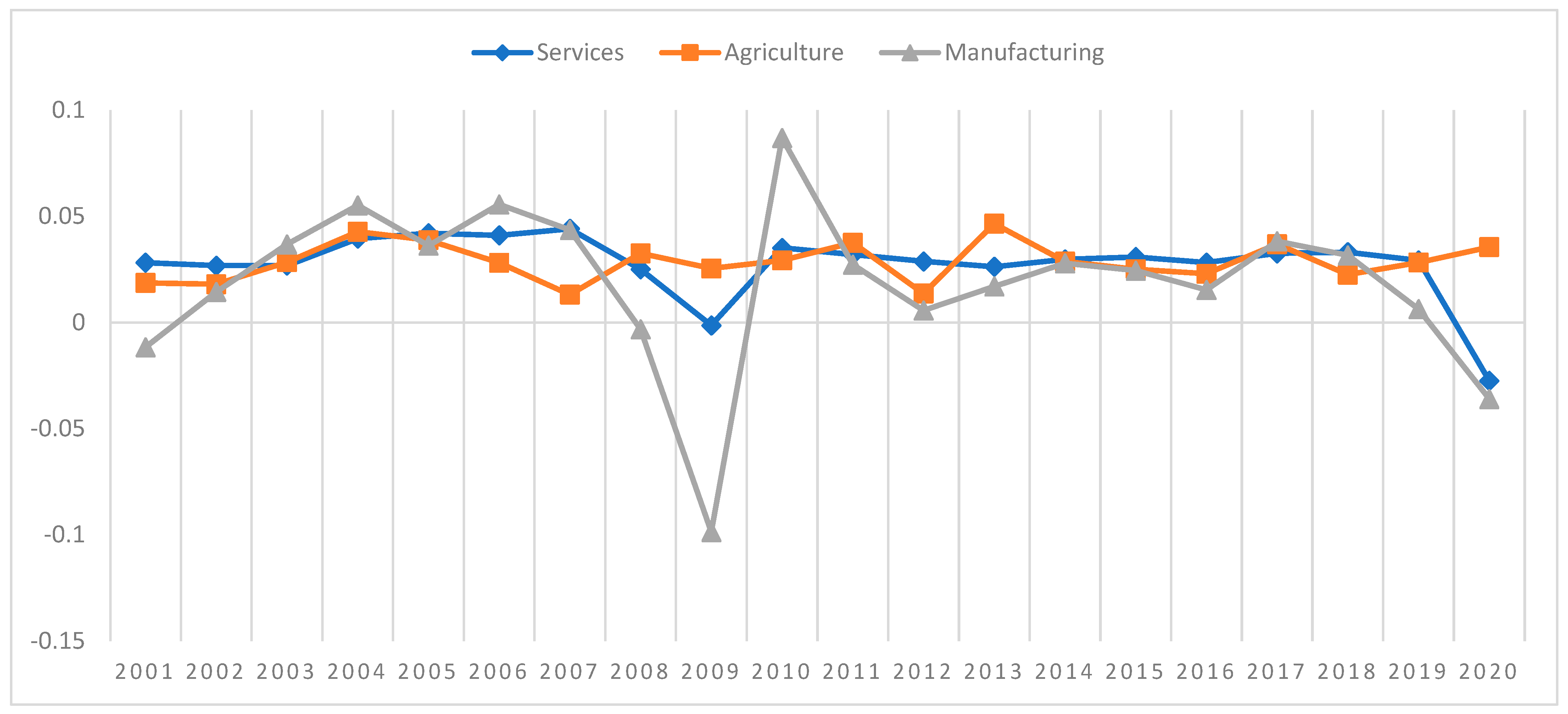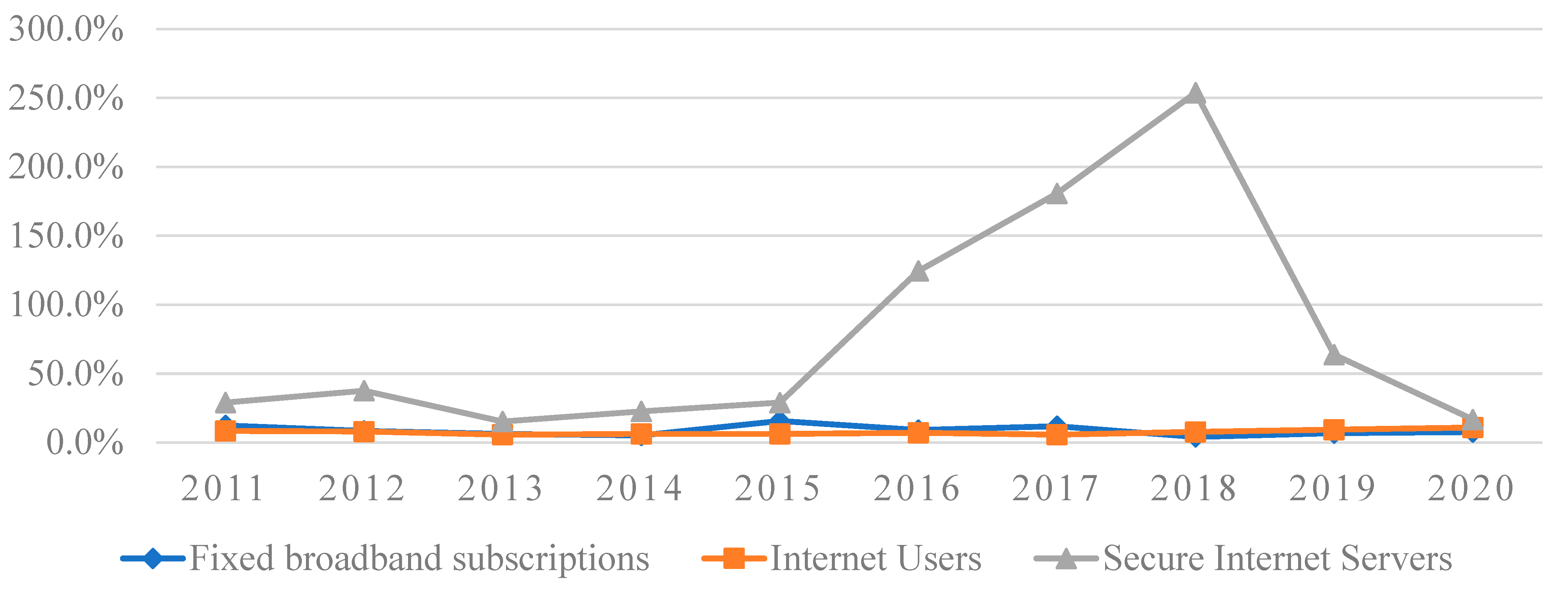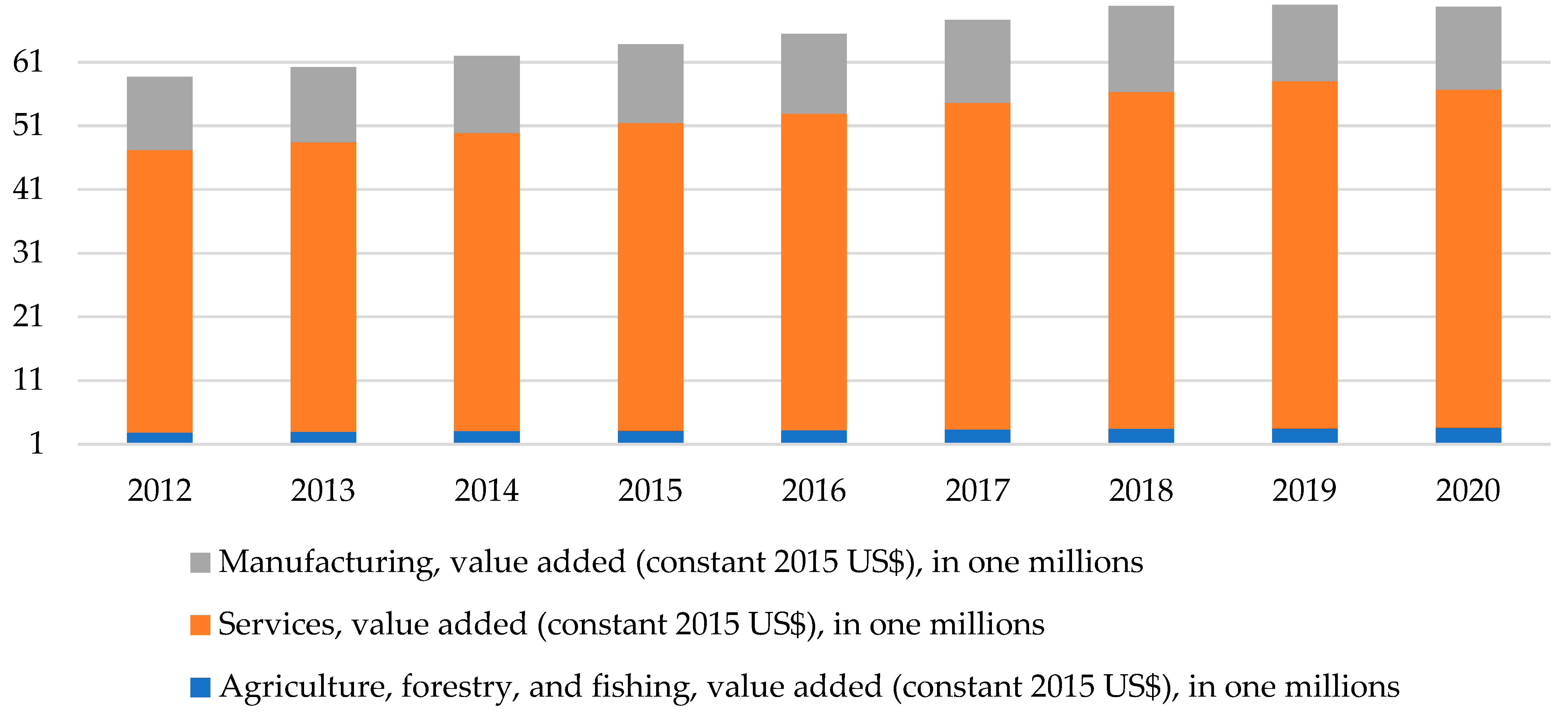The Role of Internet on Agricultural Sector Performance in Global World
Abstract
:1. Introduction
2. Methodology and Data
3. Results
3.1. Trends of Internet Variables
3.2. The Effect of the Internet on Agricultural Sector Performance (Global)
3.3. The Effect of the Internet on Agricultural Sector Performance (Two Classifications)
4. Discussion
5. Conclusions
Author Contributions
Funding
Data Availability Statement
Acknowledgments
Conflicts of Interest
Appendix A
| Continents | Countries |
|---|---|
| Africa | Algeria, Angola, Benin, Botswana, Burkina Faso, Burundi, Cabo Verde, Cameroon, Chad, Côte d’Ivoire, Egypt, Gabon, Gambia, Ghana, Guinea, Kenya, Lesotho, Malawi, Mauritania, Mauritius, Morocco, Mozambique, Namibia, Nigeria, Rwanda, Senegal, South Africa, Togo, Tunisia, United Republic of Tanzania, Zambia, and Zimbabwe. |
| Asia and Oceania | Albania, Armenia, Australia, Azerbaijan, Bahrain, Bangladesh, Bhutan, Brunei Darussalam, China, Cyprus, Georgia, India, Indonesia, Iran (Islamic Republic of), Israel, Japan, Kazakhstan, Kuwait, Kyrgyzstan, Lao People’s Democratic Republic, Malaysia, Maldives, Mongolia, Nepal, New Zealand, Oman, Pakistan, Philippines, Republic of Korea, Singapore, Thailand, Timor-Leste, Türkiye, United Arab Emirates and Uzbekistan. |
| America | Argentina, Bahamas, Belize, Bolivia (Plurinational State of), Brazil, Canada, Chile, Colombia, Costa Rica, Dominican Republic, Ecuador, El Salvador, Honduras, Mexico, Nicaragua, Panama, Paraguay, Peru, Saint Lucia, Suriname, United States of America, and Uruguay. |
| Europe | Austria, Belarus, Belgium, Bosnia and Herzegovina, Bulgaria, Croatia, Czechia, Denmark, Estonia, Finland, France, Germany, Greece, Hungary, Iceland, Ireland, Italy, Latvia, Lithuania, Luxembourg, Malta, Montenegro, Netherlands, North Macedonia, Norway, Poland, Portugal, Romania, Russian Federation, Serbia, Slovakia, Slovenia, Spain, Sweden, Switzerland, Ukraine, United Kingdom of Great Britain and Northern Ireland. |
| Classifications | Countries |
|---|---|
| Advanced economies | Australia, Austria, Belgium, Canada, Cyprus, Czechia, Denmark, Estonia, Finland, France, Germany, Greece, Iceland, Ireland, Israel, Italy, Japan, Latvia, Lithuania, Luxembourg, Malta, Netherlands, New Zealand, Norway, Portugal, Republic of Korea, Singapore, Slovakia, Slovenia, Spain, Sweden, Switzerland, United Kingdom of Great Britain and Northern Ireland, and United States of America. |
| Emerging and developing economies | Albania, Algeria, Angola, Argentina, Armenia, Azerbaijan, Bahamas, Bahrain, Bangladesh, Belarus, Belize, Benin, Bhutan, Bolivia (Plurinational State of), Bosnia and Herzegovina, Botswana, Brazil, Brunei Darussalam, Bulgaria, Burkina Faso, Burundi, Cabo Verde, Cameroon, Chad, Chile, China mainland, Colombia, Costa Rica, Côte d’Ivoire, Croatia, Dominican Republic, Ecuador Egypt, El Salvador, Gabon, Gambia, Georgia, Ghana, Guinea, Honduras, Hungary, India, Indonesia, Iran (Islamic Republic of), Kazakhstan, Kenya, Kuwait, Kyrgyzstan, Lao People’s Democratic Republic, Lesotho, Malawi, Malaysia, Maldives, Mauritania, Mauritius, Mexico, Mongolia, Montenegro, Morocco, Mozambique, Namibia, Nepal, Nicaragua, Nigeria, North Macedonia, Oman, Pakistan, Panama, Paraguay, Peru, Philippines, Poland, Romania, Russian Federation, Rwanda, Saint Lucia, Senegal, Serbia, South Africa, Suriname, Thailand, Timor-Leste, Togo, Tunisia, Türkiye, Ukraine, United Arab Emirates, United Republic of Tanzania, Uruguay, Uzbekistan, Zambia, and Zimbabwe. |
References
- Choi, C.; Hoon Yi, M. The effect of the Internet on economic growth: Evidence from cross-country panel data. Econ. Lett. 2009, 105, 39–41. [Google Scholar] [CrossRef]
- Manyika, J.; Roxburgh, C. The great transformer: The impact of the Internet on Economic Growth and Prosperity; McKinsey Global Institute: Washington, DC, USA, 2011. [Google Scholar]
- Meijers, H. Does the internet generate economic growth, international trade, or both? Int. Econ. Econ. Policy 2014, 11, 137–163. [Google Scholar] [CrossRef]
- Maurseth, P.B. The effect of the Internet on economic growth: Counter-evidence from cross-country panel data. Econ. Lett. 2018, 172, 74–77. [Google Scholar] [CrossRef]
- Buevich, A.; Karamova, O.; Sumarokov, E. Improvement of the institutional structure of the real sector under the conditions of the digital economy. In Studies in Computational Intelligence; Springer: Cham, Switzerland, 2019; Volume 826. [Google Scholar]
- Kaloxylos, A.; Wolfert, J.; Verwaart, T.; Terol, C.M.; Brewster, C.; Robbemond, R.; Sundmaker, H. The Use of Future Internet Technologies in the Agriculture and Food Sectors: Integrating the Supply Chain. Procedia Technol. 2013, 8, 51–60. [Google Scholar] [CrossRef]
- Khan, F.A.; Abubakar, A.; Mahmoud, M.; Al-Khasawneh, M.A.; Alarood, A.A. Cotton crop cultivation oriented semantic framework based on IoT smart farming application. Int. J. Eng. Adv. Technol. 2019, 8, 480–484. [Google Scholar]
- Kour, V.P.; Arora, S. Recent Developments of the Internet of Things in Agriculture: A Survey. IEEE Access 2020, 8, 129924–129957. [Google Scholar] [CrossRef]
- Heang, J.F.; Khan, H.U. The Role of Internet Marketing in the Development of Agricultural Industry: A Case Study of China. J. Internet Commer. 2015, 14, 65–113. [Google Scholar] [CrossRef]
- World Bank. World Development Indicator (WDI) [Internet]. 2022. Available online: https://data.worldbank.org/ (accessed on 1 August 2022).
- Stiglitz, J.E. Lessons from the Financial Crisis and Their Implications for Global Economic Policy. Acad. Commons 2018, 227–238. [Google Scholar] [CrossRef]
- May, J.; Karugia, J.; Ndokweni, M. Information and Communication Technologies and Agricultural Development in sub-Saharan Africa. 2007. Available online: https://www.africaportal.org/publications/information-and-communication-technologies-and-agricultural-development-in-sub-saharan-africa-transformation-and-employment-generation/ (accessed on 3 August 2022).
- Rehman, A.; Saba, T.; Kashif, M.; Fati, S.M.; Bahaj, S.A.; Chaudhry, H. A Revisit of Internet of Things Technologies for Monitoring and Control Strategies in Smart Agriculture. Agronomy 2022, 12, 127. [Google Scholar] [CrossRef]
- Srivastava, A.; Dashora, K. Application of blockchain technology for agrifood supply chain management: A systematic literature review on benefits and challenges. Benchmarking 2022. [Google Scholar] [CrossRef]
- Feng, H.; Wang, X.; Duan, Y.; Zhang, J.; Zhang, X. Applying blockchain technology to improve agri-food traceability: A review of development methods, benefits and challenges. J. Clean. Prod. 2020, 260, 121031. [Google Scholar] [CrossRef]
- Suroso, A.I.; Rifai, B.; Hasanah, N. Traceability System in Hydroponic Vegetables Supply Chain Using Blockchain Technology. Int. J. Inf. Manag. Sci. 2021, 32, 347–361. [Google Scholar] [CrossRef]
- Suroso, A.I.; Ramadhan, A. Decision support system for agribusiness investment as e-Government service using computable general equilibrium model. In Proceedings of the Advances in Intelligent and Soft Computing; Springer: Berlin/Heidelberg, Germany, 2012; Volume 144 AISC. [Google Scholar]
- Suroso, A.I.; Ramadhan, A. Structural path analysis of the influences from smallholder oil palm plantation toward household income: One aspect of e-Government initative. Adv. Sci. Lett. 2014, 20, 352–356. [Google Scholar] [CrossRef]
- Panetto, H.; Lezoche, M.; Hernandez Hormazabal, J.E.; del Mar Eva Alemany Diaz, M.; Kacprzyk, J. Special issue on Agri-Food 4.0 and digitalization in agriculture supply chains—New directions, challenges and applications. Comput. Ind. 2020, 116, 103188. [Google Scholar] [CrossRef]
- Yadav, P.; Sharma, A.K. Agriculture Credit in Developing Economies: A Review of Relevant Literature. Int. J. Econ. Financ. 2015, 7, 219–244. [Google Scholar] [CrossRef]
- Chatterjee, R. Indian agriculture and role of agricultural extension system to cope up with COVID-19 crisis. Food Sci. Rep. 2020, 1, 10–15. [Google Scholar]
- Mondiale, B. World Development Report, 2008: Agriculture for Development; World Bank: Washington, DC, USA, 2008; Volume 45. [Google Scholar]
- Lio, M.; Liu, M.C. ICT and agricultural productivity: Evidence from cross-country data. Agric. Econ. 2006, 34, 221–228. [Google Scholar] [CrossRef]
- Hopestone, K.C. The role of ICTs in agricultural production in Africa. J. Dev. Agric. Econ. 2014, 6, 279–289. [Google Scholar] [CrossRef]
- Ali, S.; Jabeen, U.A.; Nikhitha, M. Impacts of ICTs on agricultural productivity. Eur. J. Bus. Econ. Account. 2016, 4, 82–92. [Google Scholar]
- Evans, O. Digital Agriculture: Mobile Phones, Internet & Agricultural Development in Africa; University Library of Munich: Munich, Germany, 2018; Volume 7–8. [Google Scholar]
- Oyelami, L.O.; Sofoluwe, N.A.; Ajeigbe, O.M. ICT and agricultural sector performance: Empirical evidence from sub—Saharan Africa. Future Bus. J. 2022, 8, 1–13. [Google Scholar] [CrossRef]
- Solow, R.M. A contribution to the theory of economic growth. Q. J. Econ. 1956, 70, 65–94. [Google Scholar] [CrossRef]
- Romer, P.M. Increasing Returns and Long-Run Growth. J. Polit. Econ. 1986, 94, 1002–1037. [Google Scholar] [CrossRef]
- Chitedze, I.; Nwedeh, C.C.N.; Adeola, A.; Abonyi, D.C.C. An econometric analysis of electricity consumption and real sector performance in Nigeria. Int. J. Energy Sect. Manag. 2021, 15, 855–873. [Google Scholar] [CrossRef]
- Asongu, S.A.; Odhiambo, N.M. Foreign direct investment, information technology and economic growth dynamics in Sub-Saharan Africa. Telecomm. Policy 2020, 44, 101838. [Google Scholar] [CrossRef]
- Franke, G.R. Multicollinearity. In Wiley International Encyclopedia of Marketing; Wiley-Blackwell: Hoboken, NJ, USA, 2010. [Google Scholar]
- Senaviratna, N.A.M.R.; Cooray, T.M.J.A. Diagnosing Multicollinearity of Logistic Regression Model. Asian J. Probab. Stat. 2019, 5, 1–9. [Google Scholar] [CrossRef]
- Chege, S.M.; Wang, D. The influence of technology innovation on SME performance through environmental sustainability practices in Kenya. Technol. Soc. 2020, 60, 101210. [Google Scholar] [CrossRef]
- Ayim, C.; Kassahun, A.; Addison, C.; Tekinerdogan, B. Adoption of ICT innovations in the agriculture sector in Africa: A review of the literature. Agric. Food Secur. 2022, 11, 1–16. [Google Scholar] [CrossRef]
- Mendelsohn, R.; Dinar, A. Climate change, agriculture, and developing countries: Does adaptation matter? World Bank Res. Obs. 1999, 14, 277–293. [Google Scholar] [CrossRef]
- Madushanki, A.A.R.; Halgamuge, M.N.; Wirasagoda, W.A.H.S.; Syed, A. Adoption of the Internet of Things (IoT) in agriculture and smart farming towards urban greening: A review. Int. J. Adv. Comput. Sci. Appl. 2019, 10. [Google Scholar] [CrossRef]
- Gupta, A.; Ponticelli, J.; Tesei, A. Information, Technology Adoption and Productivity: The Role of Mobile Phones in Agriculture. SSRN Electron. J. 2021. [Google Scholar] [CrossRef]
- Shin, D.H. User acceptance of mobile Internet: Implication for convergence technologies. Interact. Comput. 2007, 19, 472–483. [Google Scholar] [CrossRef]
- Chatzimichail, A.; Chatzigeorgiou, C.; Tsanousa, A.; Ntioudis, D.; Meditskos, G.; Andritsopoulos, F.; Karaberi, C.; Kasnesis, P.; Kogias, D.G.; Gorgogetas, G.; et al. Internet of things infrastructure for security and safety in public places. Information 2019, 10, 333. [Google Scholar] [CrossRef] [Green Version]
- Statistic Times. List of Countries by Continents. 2019. Available online: https://statisticstimes.com/geography/countries-by-continents.php (accessed on 5 August 2022).
- International Monetary Fund [IMF]. World Economic Outlook, Database—WEO Groups and Aggregates Information. 2022. Available online: https://www.imf.org/external/pubs/ft/weo/2021/02/weodata/groups.htm (accessed on 3 March 2022).



| Variables | Unit | Source | Expected Sign |
|---|---|---|---|
| Log(Agri) | Constant, 2015 USD | World Bank Open Data | − |
| Log(GFCF) | Value Prices, 2015 USD | FAOStat | + |
| Log(EMP) | 1000 Persons | FAOStat | + |
| INT | % Internet users | World Bank Open Data | + |
| Log(FBS) | Subscriptions | World Bank Open Data | + |
| Log(SIS) | Distinct numbers | World Bank Open Data | + |
| Variables | Mean | Median | Maximum | Minimum | Std. Dev. | N |
|---|---|---|---|---|---|---|
| LOG(AGRI) | 22.037 | 21.990 | 27.692 | 17.369 | 1.897 | 1008 |
| LOG(GFCF) | 6.291 | 6.373 | 11.925 | 0.816 | 2.106 | 1008 |
| LOG(EMP) | 6.233 | 6.221 | 12.455 | 0.045 | 2.323 | 1008 |
| INT | 54.442 | 58.139 | 99.701 | 1.220 | 27.881 | 1008 |
| LOG(FBS) | 13.201 | 13.557 | 19.923 | 3.714 | 2.610 | 1008 |
| LOG(SIS) | 7.710 | 7.551 | 17.522 | 0.000 | 3.245 | 1008 |
| Variables | Log(GFCF) | Log(EMP) | INT | Log(FBS) | Log(SIS) |
|---|---|---|---|---|---|
| Log(GFCF) | 1.000 | ||||
| Log(EMP) | 0.571 | 1.000 | |||
| INT | 0.211 | −0.544 | 1.000 | ||
| Log(FBS) | 0.782 | 0.214 | 0.569 | 1.000 | |
| Log(SIS) | 0.673 | 0.000 | 0.717 | 0.825 | 1.000 |
| Variables | OLS | FEM | REM |
|---|---|---|---|
| C | 15.275 *** | 20.546 *** | 17.533 *** |
| LOG(GFCF) | 0.584 *** | 0.135 *** | 0.326 *** |
| LOG(EMP) | 0.310 *** | 0.034 * | 0.287 *** |
| INT | 0.003 ** | 0.003 *** | 0.000 |
| LOG(FBS) | 0.100 *** | 0.014 ** | 0.038 *** |
| LOG(SIS) | −0.040 *** | 0.011 *** | 0.020 *** |
| R-squared | 0.952 | 0.998 | 0.599 |
| F-statistic | 3942.465 | 4472.101*** | 299.879 *** |
| N | 1008 | 1008 | 1008 |
| Chow test | - | 218.302*** | - |
| Hausman test | - | - | 653.154 *** |
| Variables | Asia and Oceania | Africa | Europe | America | ||||
|---|---|---|---|---|---|---|---|---|
| FEM | REM | FEM | REM | FEM | REM | FEM | REM | |
| C | 21.173 *** | 17.311 *** | 17.679 *** | 16.160 *** | 18.690 | 12.040 *** | 20.051 *** | 16.790 *** |
| LOG(GFCF) | 0.067 *** | 0.269 *** | 0.196 *** | 0.291 *** | 0.019 | 0.080 *** | 0.266 *** | 0.561 *** |
| LOG(EMP) | −0.004 | 0.346 *** | 0.384 *** | 0.514 *** | 0.045 | 0.175 *** | −0.004 | 0.104 *** |
| INT | 0.003 *** | −0.001 | 0.005 *** | 0.004 *** | 0.001 | −0.003 * | 0.002 | −0.002 |
| LOG(FBS) | 0.042 *** | 0.067 *** | −0.002 | 0.005 | 0.190 | 0.599 *** | 0.020 | 0.087 ** |
| LOG(SIS) | 0.009 | 0.024 *** | 0.007 | 0.002 | 0.007 | −0.004 | 0.015 | 0.029 ** |
| R-squared | 0.999 | 0.687 | 0.998 | 0.701 | 0.997 | 0.613 | 0.999 | 0.730 |
| F-statistic | 7971.846 *** | 120.223 *** | 3272.359 *** | 117.339 *** | 2404.758 *** | 91.861 *** | 4281.781 *** | 92.021 *** |
| N | 280 | 280 | 256 | 256 | 296 | 296 | 176 | 176 |
| Chow test | 227.732 *** | 184.364 *** | 155.964 *** | 123.846 *** | ||||
| Hausman test | 275.360 *** | 99.298 *** | 59.857 *** | 91.395 *** | ||||
| Variables | Advanced Economies | Emerging and Developing Economies | ||
|---|---|---|---|---|
| FEM | REM | FEM | REM | |
| C | 21.213 *** | 12.246 *** | 20.373 *** | 17.564 *** |
| LOG(GFCF) | 0.005 | 0.120 *** | 0.173 *** | 0.351 *** |
| LOG(EMP) | −0.030 | 0.215 *** | 0.036 * | 0.272 *** |
| INT | 0.001 | −0.004 ** | 0.003 *** | 0.000 |
| LOG(FBS) | 0.065 | 0.564 *** | 0.010 | 0.026 *** |
| LOG(SIS) | 0.010 | −0.001 | 0.013 *** | 0.021 *** |
| R-Square | 0.998 | 0.547 | 0.999 | 0.648 |
| F-Statistics | 3440.032 *** | 64.148 *** | 4904.065 | 269.184 |
| N | 272 | 272 | 736 | 736 |
| Chow Test | 221.099 *** | 208.306 *** | ||
| Hausman Test | 89.789 *** | 499.726 *** | ||
Publisher’s Note: MDPI stays neutral with regard to jurisdictional claims in published maps and institutional affiliations. |
© 2022 by the authors. Licensee MDPI, Basel, Switzerland. This article is an open access article distributed under the terms and conditions of the Creative Commons Attribution (CC BY) license (https://creativecommons.org/licenses/by/4.0/).
Share and Cite
Suroso, A.I.; Fahmi, I.; Tandra, H. The Role of Internet on Agricultural Sector Performance in Global World. Sustainability 2022, 14, 12266. https://doi.org/10.3390/su141912266
Suroso AI, Fahmi I, Tandra H. The Role of Internet on Agricultural Sector Performance in Global World. Sustainability. 2022; 14(19):12266. https://doi.org/10.3390/su141912266
Chicago/Turabian StyleSuroso, Arif Imam, Idqan Fahmi, and Hansen Tandra. 2022. "The Role of Internet on Agricultural Sector Performance in Global World" Sustainability 14, no. 19: 12266. https://doi.org/10.3390/su141912266
APA StyleSuroso, A. I., Fahmi, I., & Tandra, H. (2022). The Role of Internet on Agricultural Sector Performance in Global World. Sustainability, 14(19), 12266. https://doi.org/10.3390/su141912266






